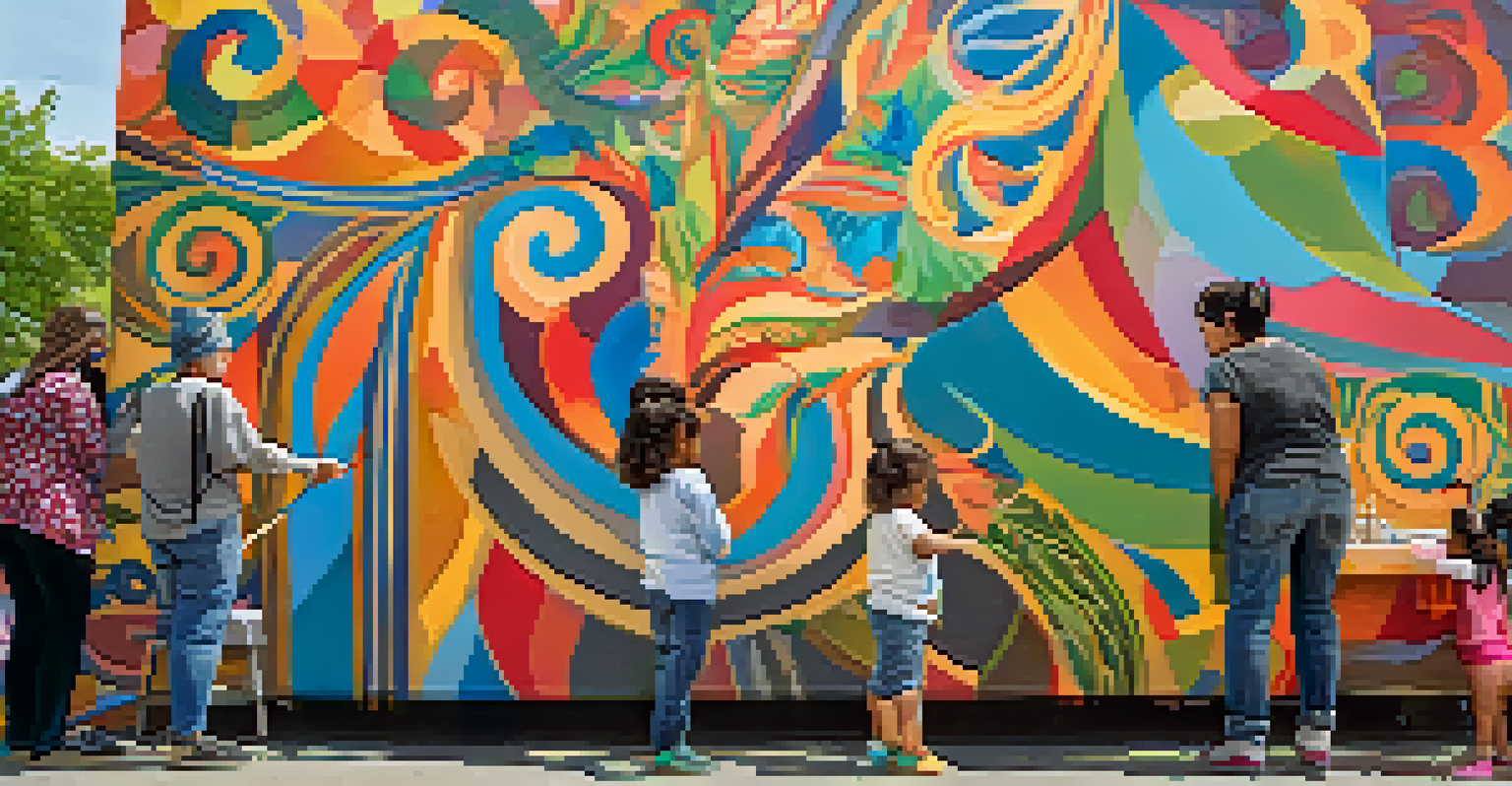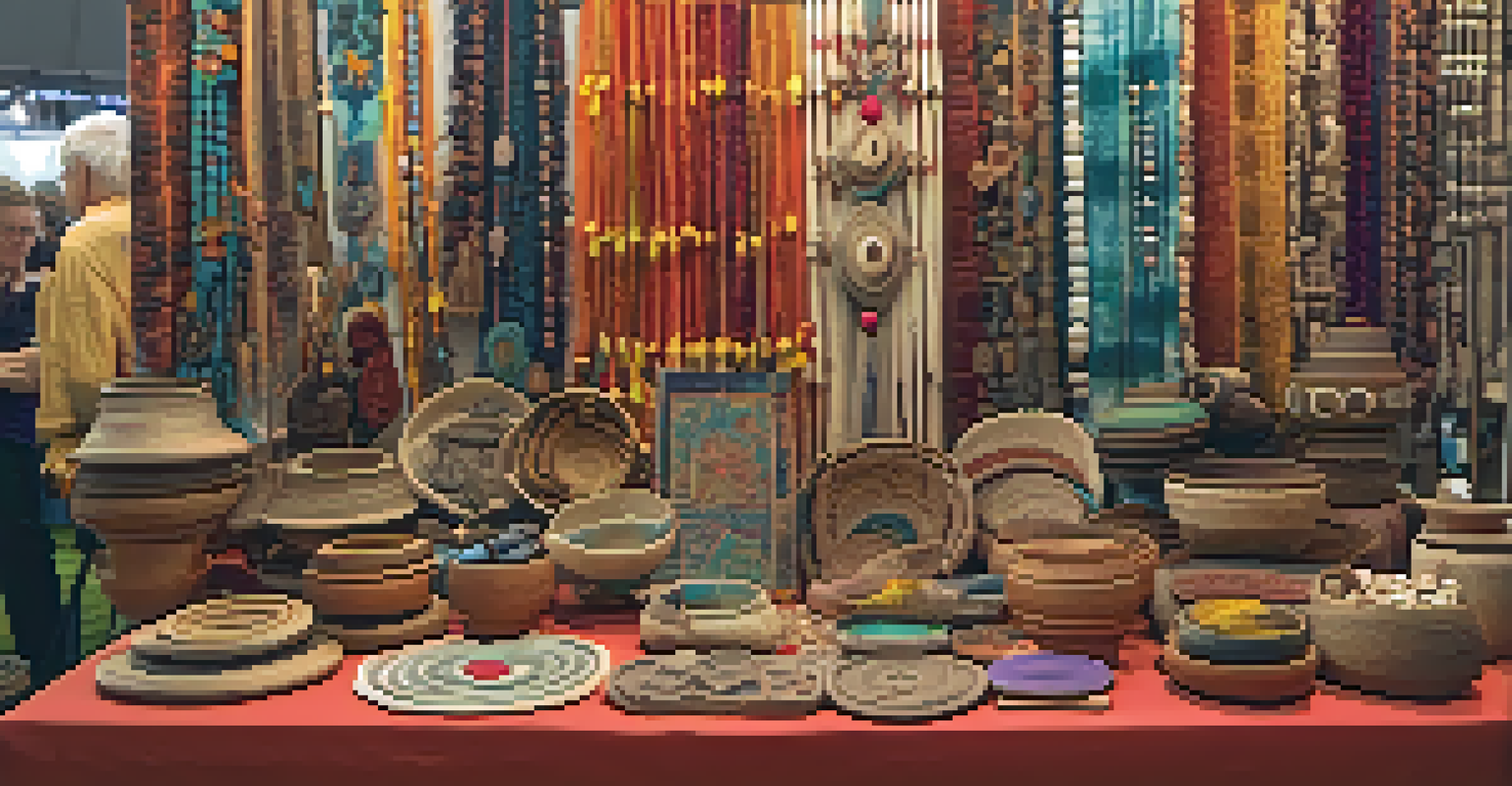The Role of Festivals in Celebrating Global Art Forms

Festivals as Cultural Showcases for Global Art Forms
Festivals serve as vibrant platforms where diverse art forms come alive, allowing cultures to share their unique narratives. By gathering artists and audiences from around the world, these events create a melting pot of creativity and inspiration. For instance, the Edinburgh Festival Fringe invites performers from various backgrounds, offering a stage for everything from theater to stand-up comedy.
Art is the most beautiful of all lies.
This convergence not only fosters appreciation for different art styles but also encourages collaboration among artists. As they exchange ideas and techniques, new art forms can emerge, enriching the global artistic landscape. The cross-pollination of cultures at festivals often leads to innovative expressions that may not have been possible in isolation.
Moreover, festivals often highlight traditional art forms, ensuring they are preserved for future generations. By showcasing these practices, festivals remind attendees of the rich histories and stories behind each art form, making them not just events, but vital cultural experiences.
Promoting Cultural Awareness Through Artistic Expression
Festivals play a crucial role in promoting cultural awareness by celebrating the artistry of various communities. They invite attendees to immerse themselves in different cultures, fostering a sense of understanding and appreciation. For example, the Carnival of Venice showcases the intricate artistry of mask-making, drawing visitors into its enchanting world.

Through performances, visual arts, and culinary experiences, festivals allow attendees to experience cultures firsthand. This engagement can break down stereotypes and foster empathy among diverse groups. When people witness the beauty of another culture’s art, it often inspires a desire to learn more and connect on a deeper level.
Festivals Unite Global Cultures
Art festivals serve as vibrant platforms that foster collaboration and cultural exchange among diverse artists and audiences.
Additionally, the exposure to global art forms can challenge preconceived notions and broaden perspectives. By celebrating diversity through art, festivals create a sense of unity and respect among various cultures, reminding us of the beauty in our differences.
Economic Impact of Art Festivals on Local Communities
Art festivals are not just cultural events; they also have significant economic implications for local communities. By attracting visitors from near and far, these festivals generate revenue through tourism, hospitality, and local businesses. Cities that host renowned festivals, like the Sundance Film Festival, often see a substantial boost in their economies.
The purpose of art is not a rarified, intellectual distillate; it is a visceral and flesh-and-blood affair.
Moreover, local artists benefit from increased visibility and opportunities to showcase their work. Festivals often provide platforms for emerging artists to connect with potential buyers and patrons, which can be pivotal for their careers. This support for local talent fosters a thriving arts community, encouraging creativity and innovation.
In addition to direct financial benefits, festivals can enhance the overall appeal of a location. They contribute to a city’s cultural identity, making it a more attractive place for residents and tourists alike. As art festivals grow in popularity, they can transform towns into vibrant cultural hubs.
Fostering Community Engagement and Participation
One of the most beautiful aspects of festivals is their ability to bring communities together. Local residents often participate not just as attendees but as contributors, whether through volunteering, performing, or showcasing their art. This sense of ownership can strengthen community bonds and instill pride in local culture.
For instance, community art festivals often feature workshops and interactive sessions, allowing attendees to engage directly with the art. These experiences can spark creativity in individuals who may not have considered themselves artists, promoting inclusivity and participation across all ages. When people create together, it fosters a sense of camaraderie that enhances community spirit.
Economic Boost for Local Communities
Art festivals significantly enhance local economies by attracting tourists and providing opportunities for local artists.
Furthermore, festivals can serve as platforms for social change, giving voice to local issues through artistic expression. By addressing topics such as sustainability or social justice, art festivals can inspire dialogue and motivate audiences to take action in their communities.
The Role of Technology in Modern Art Festivals
In today’s digital age, technology plays an increasingly important role in art festivals. From virtual reality experiences to live-streamed performances, technology enhances how attendees engage with art. For example, the Coachella Valley Music and Arts Festival utilizes advanced technology to create immersive installations that captivate audiences.
Moreover, technology allows festivals to reach a broader audience beyond geographical limitations. Virtual participation has become more common, enabling art lovers from around the world to experience festivals without leaving their homes. This inclusivity is essential in a globalized world where access to culture should not be limited by location.
Additionally, social media has transformed how festivals promote themselves and interact with audiences. Artists can use platforms like Instagram to showcase their work, while festival organizers can share live updates, keeping everyone connected and engaged throughout the event.
Environmental Sustainability in Art Festivals
As awareness of environmental issues grows, many art festivals are taking steps to promote sustainability. Organizers are implementing eco-friendly practices, such as reducing waste, promoting recycling, and utilizing renewable energy sources. Festivals like Glastonbury have made significant strides in minimizing their environmental footprint while still providing a memorable experience.
Moreover, artists are often encouraged to create works that reflect themes of sustainability and conservation. By showcasing environmentally conscious art, festivals not only entertain but also educate attendees about pressing ecological issues. This dual focus on creativity and environmental responsibility can inspire change within communities.
Sustainability Drives Future Festivals
As environmental awareness grows, festivals are increasingly adopting sustainable practices to reduce their ecological impact.
Additionally, sustainability initiatives can enhance a festival’s appeal, attracting eco-conscious attendees. As more people seek experiences that align with their values, festivals that prioritize sustainability can stand out in a crowded market, ensuring their longevity and success.
The Future of Festivals and Global Art Forms
As we look to the future, the role of festivals in celebrating global art forms will likely continue to evolve. With advancements in technology and shifting cultural dynamics, festivals must adapt to meet the changing needs and interests of audiences. This adaptability will be key to their survival and relevance in an ever-changing world.
Moreover, the increasing emphasis on inclusivity and representation in the arts will shape the future of festivals. Organizers will need to ensure diverse voices are heard, showcasing underrepresented artists and art forms. This commitment to diversity can create richer experiences for attendees and foster a more equitable arts landscape.

Ultimately, the future of festivals will hinge on their ability to remain relevant and meaningful. By embracing change while honoring tradition, festivals can continue to be vital spaces for celebrating global art forms and fostering cultural understanding.